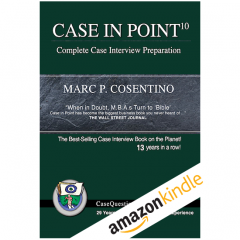There are three kinds of people in the world, those good at math and those not so good.
Sometimes there will be a little, sometimes a lot, but nothing that you haven’t seen before. The most common math you’ll see in a case interview are percentages, ROI, break-evens, weighted averages, net present value, and multiplication and division with lots of zeros. But you can’t use a calculator. The reasons they make you do math without a calculator are to see how you think and to see if you think.
How you think: I’ve seen students do the same math problem different ways. Do you use scientific notation or turn everything into a fraction? The interviewer is curious about how you go about solving the problem. He is also looking to see if you take shortcuts. An example might be: The European pet industry was € 30 billion last year. It is expected to grow 5 percent a year, every year for the next five years. What’s it going to be five years from now? When I used to give that case live, students would figure out 5 percent of € 30 billion, add them together and then calculate 5 percent of the new number, and so on for the next four years. No one wants to watch you do the same calculation three or four times. What he could have done is say: “If the market is growing 5 percent a year every year for the next five years that’s 25 percent. But I need to take compounding into consideration so I know that it is going to be more than 25 percent but less than 30 percent. My best guess is around 28 percent. So, I’m going to calculate 30 times 1.28 and get € 38.4.
If you think: Most students have trouble with zeros. If you multiply two numbers together and the answer is supposed to be 320 million and you tell me it is 3.2 billion and 3.2 billion makes no sense at all, it’s going to raise some eyebrows, because it is showing me that you’re not thinking before you speak. And if you do that in something as important as an interview, what will you do in front of a client? Whenever you do a calculation ask yourself, “Does this number make sense?” If yes, then say it. If no, then go back and recalculate it. Once you say it, you can’t un-ring the bell.
There is a difference between private math and public math. With private math, you are at home with a calculator doing your math. With public math, no calculator and the interviewer is sitting two feet away from you watching every digit that you write down. It is a very intimidating process. You want to get in the habit of talking your interviewer through your thought process by explaining what you are going to do, then doing it. That way if you make a mistake they can correct you immediately. If you go off and do your math by yourself and come back and say “the answer is 600 million” and the interviewer says “No it isn’t.” You don’t know where you made the mistake and you’ll have to go back to the beginning of the calculations and no one wants to do that.
Read more about preparing for case interviews in



